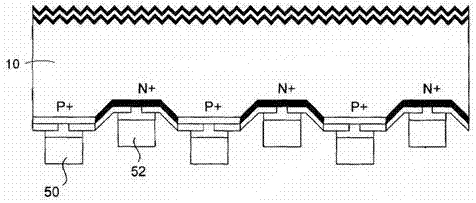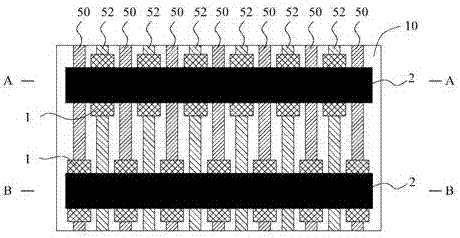Precise processing of back-contact solar cells into cell chips and electrode lead-out method
A solar cell and back-contact technology, applied in the field of solar cells, can solve the problems of high cost of materials and mechanical equipment, achieve the effects of high cost of materials and mechanical equipment, save processing costs, and improve production efficiency
- Summary
- Abstract
- Description
- Claims
- Application Information
AI Technical Summary
Problems solved by technology
Method used
Image
Examples
Embodiment 1
[0038] Such as Figure 6 As shown, the back-contact solar cell 10 of this implementation has a specification of 125X125mm produced by SUNPOWER Company of the United States, and it is necessary to cut out 18 battery chips with a specification of 32.4X20. There are 6 blocks vertically and vertically, leaving silicon chips on the left and right edges for use in other sizes, and the positive electrodes of the 3 blocks on the upper edge are drawn out, such as Figure 7 As shown, the positive terminal 5 of the back contact battery 10 itself can be used, and the negative terminal is that after the positive grid line 50 is covered by the insulating layer 1, the negative grid not covered by the insulating layer 1 is covered by the conductive layer 2 on the insulating layer 1. The line 52 is confluenced and conducted, and is drawn out from the negative poles of the three blocks below, such as Figure 9 As shown, the negative terminal 6 of the back contact battery 10 itself can be used,...
Embodiment 2
[0044] In embodiment 1, if the conductive layer 2 is a non-solderable material, it can be as follows Figure 10 and Figure 11 As shown, the conductive solderable layer 3 is screen-printed on the soldering point on the conductive layer 2, and the electrode lead wires are welded on the solderable layer 3.
Embodiment 3
[0046] Such as Figure 12 and Figure 13 As shown, in embodiment 1, the conductive profile of the copper strip 8 with the conductive adhesive layer 7 of 2 mm is used to replace the conductive layer 2, and the hot pressing process is used to bond the copper strip 8 with the conductive adhesive layer 7 to the prepared The back of the insulating layer 1 is in contact with the corresponding position of the lead-out area of the positive and negative electrodes of each battery chip to be cut out on the battery 10, so as to form the positive and negative electrode confluence and lead-out electrode terminals of each battery chip.
[0047] The production process is as follows:
[0048] 1. First place the back-contact battery 10 with the backlight facing up on the screen printing platform, and accurately set the alignment points of the grid line insulation coating screen and the back-contact battery 10, and then use the mask screen printing process, Screen printing the ink paste of ...
PUM
 Login to View More
Login to View More Abstract
Description
Claims
Application Information
 Login to View More
Login to View More - R&D
- Intellectual Property
- Life Sciences
- Materials
- Tech Scout
- Unparalleled Data Quality
- Higher Quality Content
- 60% Fewer Hallucinations
Browse by: Latest US Patents, China's latest patents, Technical Efficacy Thesaurus, Application Domain, Technology Topic, Popular Technical Reports.
© 2025 PatSnap. All rights reserved.Legal|Privacy policy|Modern Slavery Act Transparency Statement|Sitemap|About US| Contact US: help@patsnap.com



